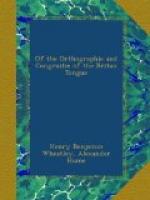10. This consonant, in latin, never followes the voual; befoer a, o, u, it keepes alwayes the awn sound, and befoer e and i breakes it.
11. But with us it may both begin and end the syllab; as, gang; it may, both behind and befoer, have either sound; as, get, gist, gin, giant.
12. These the south hath providentlie minted to distinguish tuo wayes, but hes in deed distinguished noe way, for the first sum hath used tuo gg; as, egg, legg, bigg, bagg; for the other dg; as, hedge, edge, bridge; but these ar not +kata pantos+. Gyles, nomen viri, can not be written dgiles; nor giles doli, ggiles; nether behind the voual ar they general; age, rage, suage, are never wrytten with dg. Quherfoer I conclud that, seeing nether the sound nor the symbol hath anie reason to be sundrie, without greater auctoritie, nor the reach of a privat wit, this falt is incorrigible.
13. Here I am not ignorant quhat a doe the learned make about the symboles of c, g, k and q, that they be al symboles, but of one sound; but I wil not medle in that question, being besyde my purpose, q_uhi_lk is not to correct the latin symboles, but to fynd the best use of them in our idiom.
14. T, the last of these misused souldioures, keepes alwayes it’s aun nature, excep it be befoer tio; as, oration, declamation, narration; for we pronunce not tia and tiu as it is in latin. Onelie let it be heer observed that if an s preceed tio, the t keepes the awn nature, as in question, suggestion, etc.
15. Thus have I breeflie handled the letteres and their soundes, quhilk, to end this parte, I wald wish the printeres, in their a, b, c, to expresse thus:—a, ae, ai, au, ea, b, c, d, e, ee, ei, eu, f, g, h, i, j, k, l, m, n, o, oa, oo, ou, p, q, r, s, t, u, ui, v, w, x, y, z, and the masteres teaching their puples to sound the diphthonges, not be the vouales quharof they be made, but be the sound quhilk they mak in speaking; lykwayes I wald have them name w, not duble u nor v, singl u, as now they doe; but the last, vau or ve, and the first, wau or we; and j, for difference of the voual i, written with a long tail, I wald wish to to be called jod or je.
OF THE SYLLAB.
Cap. 6.
1. Now followes the syllab, quhilk is a ful sound symbolized with convenient letteres, and consistes of ane or moe.
2. A syllab of ane letter is symbolized with a voual onelie; as, a in able, e in ever, i in idle, o in over, u in unitie, for a consonant can make no syllab alane.
3. A syllab of moe letteres is made of vouales onelie, or els of vouales and consonantes. Of onlie vouales the syllab is called a diphthong, of quhilk we have spoaken in the vouales quherof they ar composed.
4. A syllab of vouales and consonantes either begin_n_es at the voual, as al, il, el; or at one consona_n_t, as tal man; or at tuo consona_n_tes, as stand, sleep; or els at thre at the maest, as strand, stryp. It endes either at a voual, as fa, fo; or at one consonant, as ar, er; or at tuo, as best, dart; or at thre at the maest, as durst, worst.




